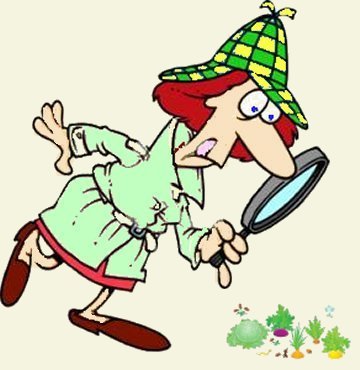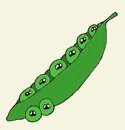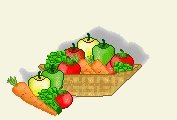AUGUST 2009
Featured Category
CDHM Asst Editor

 August. The season when Farmer's Markets spring up all across the country in the United States and farm fresh produce abounds.
August. The season when Farmer's Markets spring up all across the country in the United States and farm fresh produce abounds.
Silky-eared sweet corn, bright red tomatoes, glossy purple eggplants, deep green, bright red, Halloween orange or stop light yellow sweet peppers... the list is practically endless. Baskets and baskets of these and more sit temptingly on stands that are waist high, just right for a hand to reach out and pluck it up, raise it for an appreciative sniff.
Ah, is there anything like the scent of sunshine and dirt?
For miniaturists, the challenge lies in shrinking the dirt and capturing the sunlight. Fortunately, there's a crop of food artists who can rise to the challenge of recreating this fresh-from-the-farm vegetable look.
"For me, the best looking garden vegetables are those that have that 'just dug up' look with some dirt still clinging to them," said Alison Brand.
Getting the shrunken dirt onto the veggie can be almost as much of a challenge as creating the veggie.
"To get the effect depends on the vegetable. For carrots, I use a 'dirt' wash with acrylic paint that I just paint on then wipe off so the 'dirt' stays in the grooves. For dirtier carrots, just add more wash.
"Potatoes use a different technique. I use a fine chalk powder to get the look of 'loose dirt' on the potatoes. Just scrape your chalks into a little dish with sides to make a powder, then roll your uncooked potatoes in the powder till you get the dirt look you're after, then bake your potatoes," explained Brand.
Different clays can lend subtle differences to vegetable sculpts as well as paint and chalk techniques.
"I use Fimo & Sculpey clay to make my veggies ~ for some veggies I prefer Sculpey and for others, Fimo. To get the effects on a veggie I use chalk or acrylic paints and sometimes Crystal Glaze for a shinier glossy look, like for eggplants," said Debbe Mize.
 "The hardest veggie for me to achieve reality with has been the eggplant. There are many different colors of purple in one eggplant and it's taken me many, many tries to get it right," Mize added.
"The hardest veggie for me to achieve reality with has been the eggplant. There are many different colors of purple in one eggplant and it's taken me many, many tries to get it right," Mize added.
"I don't know that I have a 'hardest' vegetable to make but definitely the most tedious is peas! My favorite vegetable to make would have to be potatoes; you just can't go wrong with them. Just look at real life ones - they come in all shapes and sizes." said Brand with a laugh.
"I think that tomatoes make the best-looking vegetables for a garden. My favorite vegetables to make are heirloom tomatoes and pumpkins. The hardest vegetable to make would have to be an artichoke," said Sandi Palesch.
"Tomatoes and yellow squash would have to be my two favorites to make," added Mize.
All three artists have gardens in real life. For inspiration at this time of year all they have to do is pop outside and check out the harvest.
 "We plant tomatoes, cukes (cucumbers), yellow squash & zucchini squash, banana peppers, okra and hot peppers -- it's a small garden," said Mize.
"We plant tomatoes, cukes (cucumbers), yellow squash & zucchini squash, banana peppers, okra and hot peppers -- it's a small garden," said Mize.
"Our garden isn't very big, either. We don't plant a lot, actually the kids have the run of most of it but I do have my own small flower bed and some containers, one with strawberries. Each year my kids have a competition with the birds to see who gets them first! I would dearly love to grow my own vegetables but haven't found the time yet," said Brand.
"My real-life garden has flowers, mostly roses. But I also have a lot of pots filled with a variety of lettuces, herbs and tomatoes," said Palesch.
Mize enjoys utilizing her tiny harvest almost as much as the larger garden variety.
 "To make a canning table scene I gather up ceramic bowls, various veggies, knives, pot holders, resin and glass canning jars. I make my cut-up veggies from clay and then bake, cool and put into jars, fill with resin and seal," she explained.
"To make a canning table scene I gather up ceramic bowls, various veggies, knives, pot holders, resin and glass canning jars. I make my cut-up veggies from clay and then bake, cool and put into jars, fill with resin and seal," she explained.
Visit the Food Galleries today!
Custom Dolls, Houses & Miniatures / CDHM




